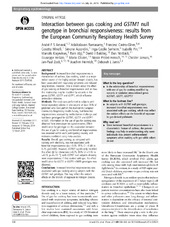Interaction between gas cooking and GSTM1 null genotype in bronchial responsiveness: Results from the European Community Respiratory Health Survey
| dc.contributor.author | Amaral, André F.S. | en_US |
| dc.contributor.author | Ramasamy, Adaikalavan | en_US |
| dc.contributor.author | Castro-Giner, Francesc | en_US |
| dc.contributor.author | Minelli, Cosetta | en_US |
| dc.contributor.author | Accordini, Simone | en_US |
| dc.contributor.author | Sørheim, Inga Cecilie | en_US |
| dc.contributor.author | Pin, Isabelle | en_US |
| dc.contributor.author | Kogevinas, Manolis | en_US |
| dc.contributor.author | Jõgi, Rain | en_US |
| dc.contributor.author | Balding, David J. | en_US |
| dc.contributor.author | Norbäck, Dan | en_US |
| dc.contributor.author | Verlato, Guiseppe | en_US |
| dc.contributor.author | Olivieri, Mario | en_US |
| dc.contributor.author | Probst-Hensch, Nicole | en_US |
| dc.contributor.author | Janson, Christer | en_US |
| dc.contributor.author | Zock, Jan-Paul | en_US |
| dc.contributor.author | Heinrich, Joachim | en_US |
| dc.contributor.author | Jarvis, Deborah L. | en_US |
| dc.date.accessioned | 2015-09-23T09:10:46Z | |
| dc.date.available | 2015-09-23T09:10:46Z | |
| dc.date.issued | 2014 | |
| dc.identifier.issn | 0040-6376 | |
| dc.identifier.issn | 1468-3296 | |
| dc.identifier.uri | https://hdl.handle.net/1956/10510 | |
| dc.description.abstract | Background: Increased bronchial responsiveness is characteristic of asthma. Gas cooking, which is a major indoor source of the highly oxidant nitrogen dioxide, has been associated with respiratory symptoms and reduced lung function. However, little is known about the effect of gas cooking on bronchial responsiveness and on how this relationship may be modified by variants in the genes GSTM1, GSTT1 and GSTP1, which influence antioxidant defences. Methods: The study was performed in subjects with forced expiratory volume in one second at least 70% of predicted who took part in the multicentre European Community Respiratory Health Survey, had bronchial responsiveness assessed by methacholine challenge and had been genotyped for GSTM1, GSTT1 and GSTP1-rs1695. Information on the use of gas for cooking was obtained from interviewer-led questionnaires. Effect modification by genotype on the association between the use of gas for cooking and bronchial responsiveness was assessed within each participating country, and estimates combined using meta-analysis. Results: Overall, gas cooking, as compared with cooking with electricity, was not associated with bronchial responsiveness (β=−0.08, 95% CI −0.40 to 0.25, p=0.648). However, GSTM1 significantly modified this effect (β for interaction=−0.75, 95% CI −1.16 to −0.33, p=4×10⁻⁴) , with GSTM1 null subjects showing more responsiveness if they cooked with gas. No effect modification by GSTT1 or GSTP1-rs1695 genotypes was observed. Conclusions: Increased bronchial responsiveness was associated with gas cooking among subjects with the GSTM1 null genotype. This may reflect the oxidant effects on the bronchi of exposure to nitrogen dioxide. | en_US |
| dc.language.iso | eng | eng |
| dc.publisher | BMJ | eng |
| dc.rights | Attribution CC BY | eng |
| dc.rights.uri | http://creativecommons.org/licenses/by/3.0/ | eng |
| dc.title | Interaction between gas cooking and GSTM1 null genotype in bronchial responsiveness: Results from the European Community Respiratory Health Survey | en_US |
| dc.type | Peer reviewed | |
| dc.type | Journal article | |
| dc.date.updated | 2015-07-30T07:06:01Z | |
| dc.description.version | publishedVersion | en_US |
| dc.rights.holder | Copyright 2014 The Authors | |
| dc.identifier.doi | https://doi.org/10.1136/thoraxjnl-2013-204574 | |
| dc.identifier.cristin | 1161553 | |
| dc.source.journal | Thorax | |
| dc.source.40 | 69 | |
| dc.source.pagenumber | 558-564 | |
| dc.subject.nsi | VDP::Medisinske fag: 700::Klinisk medisinske fag: 750::Lungesykdommer: 777 | |
| dc.subject.nsi | VDP::Midical sciences: 700::Clinical medical sciences: 750::Lung diseases: 777 |

